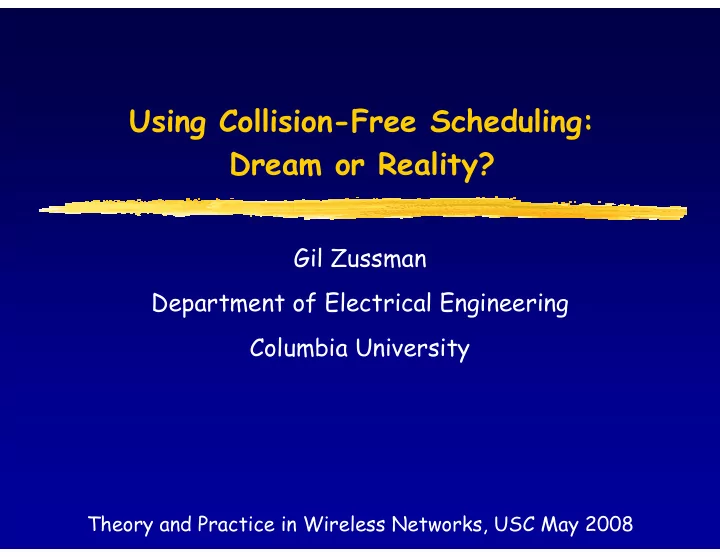

Using Collision-Free Scheduling: Dream or Reality? Gil Zussman Department of Electrical Engineering Columbia University Theory and Practice in Wireless Networks, USC May 2008
Medium Access Control � Nodes need to coordinate the access to the medium 2 • Transmission time, power, channel, rate, etc. 4 � Distributed 3 1 • Random Access (Aloha, CSMA, etc.) 6 • Collision Free (TDMA, FDMA, etc.) 5 7 8 � In the wireline domain (Ethernet) • Random Access (CSMA/CD) Collision Free (switching) � In the wireless domain • Is collision free doable? • If yes, what can be achieved? (throughput, delay, fairness, energy efficiency) • At what cost?
My First Random Access System (Winter 1990/1) � Army/Navy “Portable” Radio Communication System (AN/PRC-77) � Suffered from collisions, interference, and back pain (20 Lb.)
Our Current Random Access System* (2008) � 10 iRobot Roombas with IEEE 802.11g � Suffers from collisions and interference • But at least can clean your apartment * Jointly with J. Reich, V. Misra, and D. Rubinstein
Multihop Wireless Network Usually no predefined topology no “Links” and no “Neighbors” 2 4 3 1 6 5 8 7 Not really “Disks”
Wireless Networking Technologies SHORT < RANGE > LONG Metropolitan Area 802.16 Public Safety Military / Network / Cellular LTE 802.11b Local Area 802.11a/g/n Network Personal Area WiMedia ZigBee Network Bluetooth UWB LOW < DATA RATE > HIGH � The systems we have been experimenting with are mostly Random Access systems
IEEE 802.16 (WiMax) Mesh � Provides the backbone between the Base Stations • Can be used in Rural Areas • Nodes coordinate with their two hop neighborhood • Coordinate a collision free schedule
Military Systems � Joint Tactical Radio System (JTRS) and similar systems are being developed • Based on Software Defined Radio � There is no “one size fits all” solution • MANET between fighter planes ≠ MANET between infantry soldiers • Many waveforms • Some will use Random Access and some Collision Free
Collision Free vs. Random Access � Have been around for decades � Different systems need different approaches � (I believe) we will keep seeing both � Another important dimension - Theory vs. Practice
Theory vs. Practice Fundamental understanding of wireless networks Practical solutions to real-world networking problems Collision Free Random Access Interference Graph Models Realistic Channel Models (SINR-Based)
Ongoing Research - Collision Free/ Interference Graph � Network Model (Tassiulas and Ephremides, 1992) � Time-slotted system � Stochastic arrivals – i.i.d. process with arrival rates λ ij (are not known in advance) λ 12 , λ 14 , λ 16 1 4 3 λ 6 i , ... λ 21 , λ 24 , λ 28 2 6 5 7 8 � Only a subset of the links can be activated simultaneously, due to interference
Ongoing Research - Collision Free/ Interference Graph � Developing distributed algorithms • Based on the centralized framework of Tassiulas and Ephrimedes (1992) � Tradeoffs between decentralization, complexity, throughput, delay, fairness, and the effects of topology, and interference Decentralization/ Complexity 100% O(??) Interference Topology ?% O(?) Throughput/ Delay
Randomization approach [Modiano, Shah, Zussman, 06] � Randomized scheduling framework that achieves 100% throughput • Based on a result of Tassiulas, 1998 � Comparable complexities to the deterministic distributed greedy algorithms that achieve fractional throughput
Partitioning Approach [Brzezinski, Zussman, Modiano, 06,08] � Identified graphs in which distributed algorithms achieve 100% throughput • Based on the notion of Local Pooling (Dimakis and Walrand, 2006) � Examples • Trees under any interference degree • Chordal graphs under secondary interference
What’s Next? Collision Free Random Access Interference Graph Models Realistic Channel Models ? ( SINR > γ ) � The one time scheduling problem is already hard � Approaches for the general problem • Randomized Scheme • Local Pooling
Recommend
More recommend